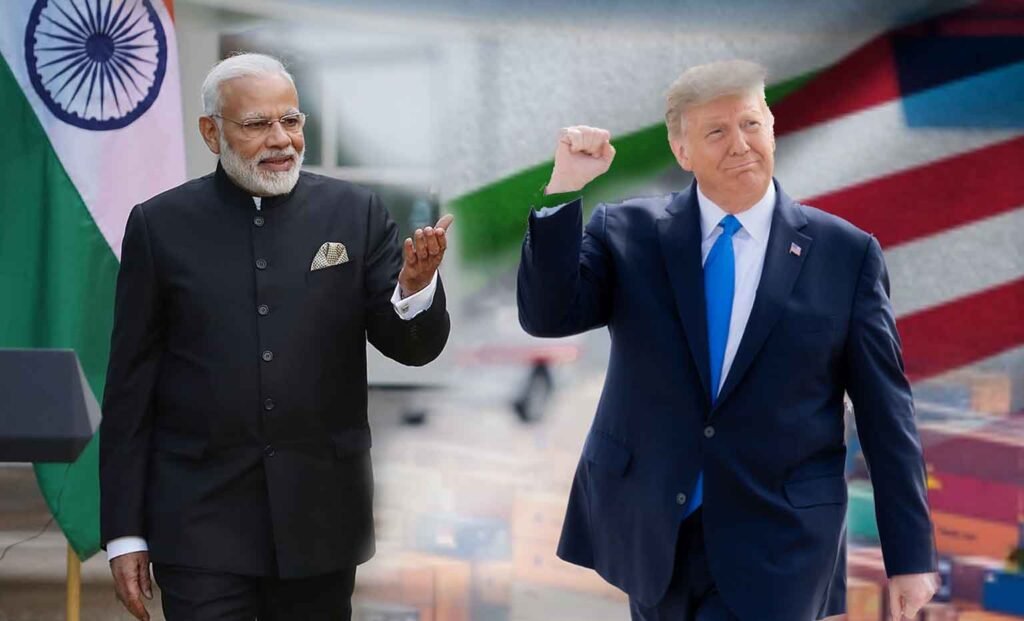As Trump revives tariff threats and India’s export economy braces for shockwaves, the Indo-US trade war is more than a bilateral skirmish—it is a strategic crossroads with deep historical roots and global implications.
A Trade War Rekindled: Trump’s Tariff Threat Reignites India’s Strategic Concerns
In August 2025, Donald Trump—once again the Republican frontrunner for the US presidential elections—warned of sweeping tariffs on imports, including those from India, in an attempt to revive his ‘America First’ economic agenda. Within days, Indian Commerce Ministry officials held high-level meetings to assess the potential blow to sectors such as pharmaceuticals, IT services, steel, and textiles. At the same time, Prime Minister Narendra Modi, during his visit to Varanasi, urged domestic shopkeepers to ‘sell only Swadeshi goods,’ a remark widely seen as both a call for economic self-reliance and a response to the shifting winds of global trade.
The rhetoric and response have reignited debate around the Indo-US trade war, an issue that began brewing over a decade ago and has now resurfaced with renewed urgency.
Timeline of Key Events: Indo-US Trade War
| Date | Event |
|---|---|
| 2018 | US imposes tariffs on steel and aluminum, affecting Indian exports |
| 2019 | India retaliates with tariffs on 28 US goods; GSP (Generalized System of Preferences) benefits withdrawn by the US |
| 2020 | Trade talks stall under COVID-19; tensions cool as global economy slows |
| 2021 | Biden administration initiates digital services tax dispute against India |
| 2023 | Limited trade dialogues resume; pharma and clean energy sectors discussed |
| 2024 | Trump announces candidacy and revives tariff narrative targeting India and China |
| July 2025 | US commerce delegation expresses concern over India’s export subsidies |
| August 2025 | Trump threatens tariffs; Modi calls for Swadeshi push; India reviews trade dependencies |
Why It Happened: Deep Structural Trade Frictions
Unequal Trade Balance
India maintains a significant trade surplus with the United States. While the US is India’s largest export destination, the imbalance has been a repeated point of contention. In 2024, India exported over $120 billion worth of goods and services to the US while importing around $80 billion—a surplus that has only grown over the past decade.
Market Access and Protectionism
India’s relatively high tariffs on agricultural goods, stringent regulatory standards, and limitations on e-commerce and data localization have drawn criticism from US administrations across party lines. American companies often cite difficulties accessing Indian markets freely, while India argues that these measures protect local industries and consumer interests.
Technology and Digital Services Tensions
A new frontier of conflict has emerged in digital taxation. India’s 2% Equalization Levy on digital services, imposed on global tech giants operating in the Indian market, led to trade retaliations and WTO consultations. The US views these measures as discriminatory, while India insists on fair taxation of revenue generated within its jurisdiction.
Economic Impact: Sector-by-Sector Breakdown
| Sector | Exports to US (2024, USD bn) | Vulnerability to Tariffs | Strategic Response |
| Pharmaceuticals | 20 | Medium | Diversification to EU, local production support |
| Textiles & Apparel | 18 | High | PLI schemes, exploring Southeast Asia & Gulf markets |
| IT Services | 36 | Medium | Push for onshore presence, AI-driven automation |
| Steel & Aluminum | 7 | High | WTO dispute channels, bilateral talks |
| Gems & Jewelry | 12 | Medium | Currency hedging, alternate trade hubs |
India’s $775 billion export economy, with the US as its single-largest buyer, faces risk of disruption if Trump’s proposed tariffs materialize. Especially vulnerable are labor-intensive sectors such as textiles, leather, and low-value manufacturing.
Strategic Context: Alliances and Alternatives
The China Factor
Both India and the US view China as a strategic competitor, but this shared concern hasn’t translated into trade harmony. India seeks to position itself as a China-plus-one alternative for global supply chains, but US firms still hesitate due to regulatory hurdles and infrastructural gaps.
Quad and Indo-Pacific Strategy
India’s participation in the Quad alliance (with the US, Japan, and Australia) provides a strategic backdrop to economic ties. However, defense alignment has not prevented economic disputes. While the Quad supports a free and open Indo-Pacific, bilateral trade policies often follow protectionist instincts.
Diversification Through FTAs
India has recently signed Free Trade Agreements with Australia, UAE, and the EU bloc. These moves are part of a larger effort to hedge against over-reliance on the US and create diversified export pathways, especially for MSMEs and manufacturing sectors.
Political Messaging and Economic Nationalism
Prime Minister Modi’s “Sell only Swadeshi” appeal is not new. It echoes previous campaigns like Make in India and Aatmanirbhar Bharat. However, its timing—immediately after Trump’s tariff threats—suggests a calibrated message of resilience and economic independence.
India’s political leadership is increasingly aligning economic rhetoric with nationalist sentiment, especially with general elections expected in 2026. The opposition, meanwhile, criticizes the government’s over-dependence on the US for trade growth.
Legal and Diplomatic Levers
WTO Mechanisms
India has repeatedly turned to the World Trade Organization to contest US tariffs, and may do so again. But the WTO’s dispute resolution mechanism has become sluggish and increasingly ineffective due to US non-cooperation in appointing appellate judges.
Bilateral Trade Talks
Backchannel dialogues have resumed post-pandemic, focusing on digital services, semiconductors, pharma supply chains, and tariff harmonization. Indian officials have hinted at a possible “mini trade deal,” but progress remains slow amid election-year politics in the US.
What Next: Navigating Uncertainty
- Short-term: India may focus on boosting domestic manufacturing and identifying alternate export markets such as Africa, Latin America, and ASEAN countries.
- Medium-term: The government is expected to accelerate PLI (Production Linked Incentive) disbursements in vulnerable sectors and push state-level export hubs.
- Long-term: Strategic decoupling from single-market dependencies, including the US and China, through resilient supply chains, FTAs, and digital infrastructure investments.
Conclusion
The Indo-US trade war is no longer a peripheral issue. It is a central test of India’s strategic autonomy, economic resilience, and diplomatic acumen. As the global order shifts and populist rhetoric reshapes economic policy in Washington, New Delhi must carefully calibrate its next moves. The answer may lie not just in retaliatory tariffs or diplomatic rebuttals, but in building a robust, diversified economic engine that can weather storms—whoever leads the White House.
India’s response to this trade conflict could redefine its global economic role for the next decade. The stakes are high. And the world is watching.


